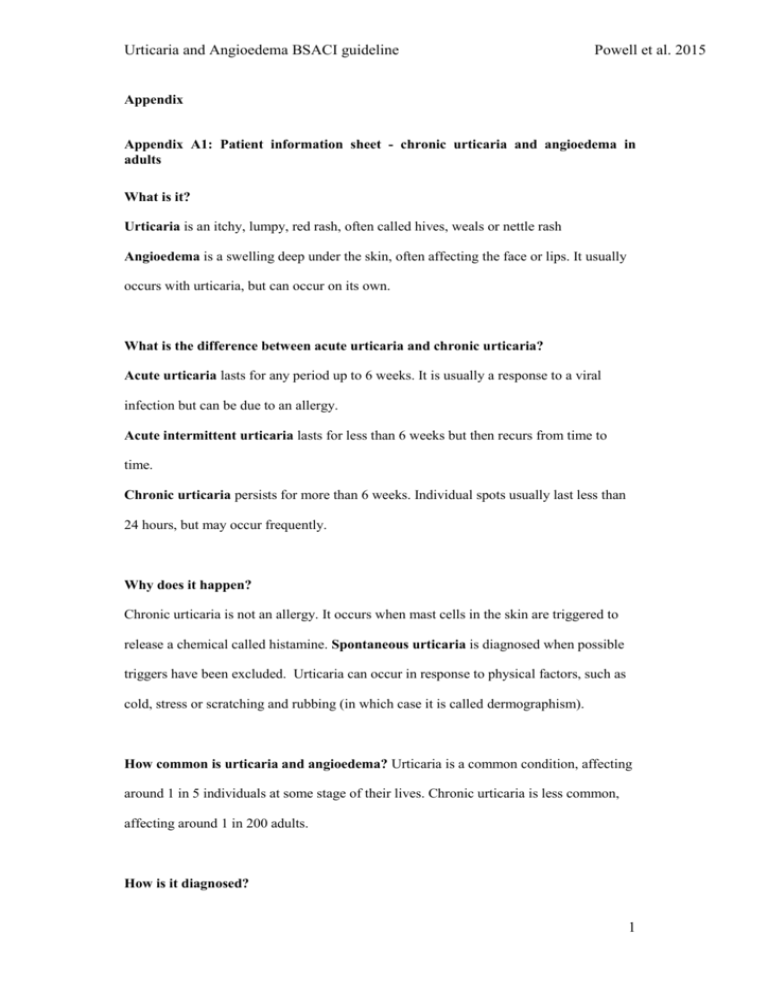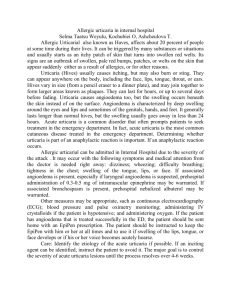cea12494-sup-0001-AppendixA1-A2
advertisement

Urticaria and Angioedema BSACI guideline Powell et al. 2015 Appendix Appendix A1: Patient information sheet - chronic urticaria and angioedema in adults What is it? Urticaria is an itchy, lumpy, red rash, often called hives, weals or nettle rash Angioedema is a swelling deep under the skin, often affecting the face or lips. It usually occurs with urticaria, but can occur on its own. What is the difference between acute urticaria and chronic urticaria? Acute urticaria lasts for any period up to 6 weeks. It is usually a response to a viral infection but can be due to an allergy. Acute intermittent urticaria lasts for less than 6 weeks but then recurs from time to time. Chronic urticaria persists for more than 6 weeks. Individual spots usually last less than 24 hours, but may occur frequently. Why does it happen? Chronic urticaria is not an allergy. It occurs when mast cells in the skin are triggered to release a chemical called histamine. Spontaneous urticaria is diagnosed when possible triggers have been excluded. Urticaria can occur in response to physical factors, such as cold, stress or scratching and rubbing (in which case it is called dermographism). How common is urticaria and angioedema? Urticaria is a common condition, affecting around 1 in 5 individuals at some stage of their lives. Chronic urticaria is less common, affecting around 1 in 200 adults. How is it diagnosed? 1 Urticaria and Angioedema BSACI guideline Powell et al. 2015 The diagnosis is made on the history and pattern of the rash. Usually, no tests are needed, although your doctor may wish to perform allergy tests to exclude this as a cause of the rash. Individuals with angioedema without urticaria may require blood tests. How is it treated? Chronic urticaria is not associated with severe allergic reactions (anaphylaxis) and adrenaline autoinjectors are not required. The itching can result in difficulty sleeping and sometimes in concentrating on tasks and hence may impact on quality of life. It is important to identify triggers that can be avoided such as cold water, stress and tight clothes. A regular dose of a non-drowsy antihistamine is often effective. This therapy may need to be taken for many months, occasionally years. It is safe to do this. Higher doses of antihistamines than are used in conditions such as hay fever may be necessary for effective control of symptoms. In some cases other medicines will need to be added. A short course of oral steroids may be needed if the swelling or rash is particularly distressing. Topical creams such as 1-2% menthol in aqueous cream may offer additional benefits. Concurrent medications Certain blood pressure tablets called ACE inhibitors can cause or aggravate angioedema (with or without associated urticaria) and you may need to discuss changing to an alternative treatment with your GP. NSAIDs such as ibuprofen, diclofenac and aspirin can aggravate urticaria and your doctor will discuss this with you. 2 Urticaria and Angioedema BSACI guideline Powell et al. 2015 How long will it last? Urticaria improves with time, but this may take a while. Lifestyle stressors may need attention with psychological support. Patient support There is no UK support group for this condition. Clinic contact number……… 3 Urticaria and Angioedema BSACI guideline Powell et al. 2015 Appendix A2: Patient information sheet - chronic urticaria and angioedema in children What is it? Urticaria is an itchy, lumpy, red rash, often called hives, weals or nettle rash Angioedema is a deep swelling in the skin, often affecting the face or lips. It usually occurs with urticaria, but can rarely occur in isolation. What is the difference between acute and chronic urticaria? Acute urticaria lasts for any period up to 6 weeks. It is usually a response to a viral infection, but may also be due to an allergy Acute intermittent urticaria lasts for less than 6 weeks, then recurs from time to time. Chronic urticaria lasts for more than 6 weeks. Individual spots usually last less than 24 hours and occur on most days. Why does it happen? Chronic urticaria is not an allergy. It occurs when mast cells in the skin are stimulated to release a chemical called histamine. In some children it arises in response to physical factors, such as cold, scratching, rubbing (in which case it is known as dermographism) or stress. Often, no cause can be found, in which case it is known as spontaneous urticaria. How common is urticaria and angioedema? Urticaria is a common condition, affecting around 10% of children at some point. Chronic urticaria is less common, affecting around 0.5% of children How is it diagnosed? 4 Urticaria and Angioedema BSACI guideline Powell et al. 2015 The diagnosis is made on the history and pattern of the rash. Usually, no tests are needed, although your doctor may wish to perform allergy tests to exclude this as a cause of the rash. If your child suffers with angioedema alone, your doctor may perform some blood tests. How is it treated? Chronic urticaria is not associated with severe allergic reactions (anaphylaxis) and adrenaline autoinjectors are not required. It can, however, cause difficulty sleeping and problems concentrating at school (impact on quality of life). Effective management is therefore important. Exposure to things which make the rash worse, such as cold weather, should be avoided, wherever possible. A regular dose of a non-drowsy antihistamine is the best treatment. The medicine may need to be taken for many months or even years. The dose of the antihistamine may need to be increased, or other medicines added. A short course of steroids may be needed if the swelling or rash is particularly severe. How long will it last? Urticaria improves with time, but this may take a while. After 3 years, a third of children with chronic urticaria are better. Most children are disease free after 7 years. 5 Urticaria and Angioedema BSACI guideline Powell et al. 2015 Table B1: Levels of evidence [149] Level of Definition evidence 1++ High quality meta-analyses, systematic reviews of RCTs, or RCTs with a very low risk of bias 1+ Well-conducted meta-analyses, systematic reviews, or RCTs with a low risk of bias 1Meta-analyses, systematic reviews, or RCTs with a high risk of bias 2++ High quality systematic reviews of case control or cohort or studies High quality case control or cohort studies with a very low risk of confounding or bias and a high probability that the relationship is causal 2+ Well-conducted case control or cohort studies with a low risk of confounding or bias and a moderate probability that the relationship is causal 2Case control or cohort studies with a high risk of confounding or bias and a significant risk that the relationship is not causal 3 Non-analytic studies, e.g. case reports, case series 4 Expert opinion Table B2: Grades of recommendations [134;149] Grade of Type of Evidence recommendation A At least one meta-analysis, systematic review, or RCT rated as 1++, and directly applicable to the target population; or A body of evidence consisting principally of studies rated as 1+, directly applicable to the target population, and demonstrating overall consistency of results B A body of evidence including studies rated as 2++, directly applicable to the target population, and demonstrating overall consistency of results; or Extrapolated evidence from studies rated as 1++ or 1+ C A body of evidence including studies rated as 2+, directly applicable to the target population and demonstrating overall consistency of results; or Extrapolated evidence from studies rated as 2++ D Evidence level 3 or 4; or Extrapolated evidence from studies rated as 2+ E Recommended best practice based on the clinical experience of the guideline development group 6 Urticaria and Angioedema BSACI guideline Powell et al. 2015 Table B3: Evidence table for the use of leukotriene receptor antagonists in chronic urticaria Source Sanada 2005 [150] Interventions Montelukast 10mg added for at least 1 week Conclusions 12/25 improved These were younger and had CIU for a shorter duration White 2005 [151] Design & Sample Non randomised uncontrolled n=25 with antihistamine uncontrolled chronic urticaria RPC n=48, crossover design 24 hour observation Di Lorenzo 2004 [122] RDBPC n=160 4 parallel groups Nettis 2004 [152] RDBPC n=81 3 parallel groups Bagenstose 2004 [81] RDBPC n=95 cetirizine refractory CIU Desloratadine, desloratadine+montelukast, montelukast alone or placebo 6 weeks treatment desloratadine alone, desloratadine+montelukast, or placebo Zafirlukast + cetirizine vs placebo + cetirizine 3 weeks treatment Fexofenidine showed greater weal and flare suppression and faster onset of action, compared with montelukast Combined treatment no better than desloratadine alone Nettis 2003 [84] N=20 with delayedpressure urticaria, DBPC. Loratadine alone compared to loratadine + montelukast. 15 days treatment Erbagci 2002 [153] RSBPC cross-over study n=30 refractory CIU. Reimers 2002 [129] Pacor 2001 [82] RDBPC n=52, cross-over design Cross-over treatments: i) montelukast + cetirizine prn; ii) placebo + cetirizine prn for 6 weeks each 6 weeks active, then 6 weeks placebo treatment Montelukast vs cetirizine vs placebo; 4 weeks treatment Nettis 2001 [154] RDBPC n=51 patients with positive ASA or food additive challenges N=27 parallel groups Montelukast vs fexofenadine 180mg; 27 days treatment Symptoms and QoL improved with combined treatment more than with desloratadine alone Improvements in urticaria scores with zafirlukast only in subgroup with positive ASST Combined treatment more effective than loratadine alone. 8/10 had complete suppression on pressure challenge. Improvement in urticaria activity scores with combined therapy No improvement with zafirlukast compared to placebo More symptom-free days in montelukast group and improved sleep quality Similar improvements in chronic urticaria for both groups. 6/9 patients with a positive ASST on montelukast became negative. 7 Urticaria and Angioedema BSACI guideline Powell et al. 2015 Table B4: Evidence table on the use of ciclosporin in chronic urticaria Source Baskan 2004 [155] Di Gioacchino 2003 [156] Grattan 2000 [87] Design & Sample N=20 open design patients with history of chronic severe spontaneous urticaria and positive ASST N=40 RDBPC patients with history of chronic severe spontaneous urticaria and positive ASST N=30 RDBPC patients with history of chronic severe spontaneous urticaria and positive ASST Interventions Ciclosporin 4mg/kg/day for either 4 or 12 weeks Conclusions Improvements in urticaria only in first month of treatment Ciclosporin 5mg/kg/day for 8 weeks then 4mg/kg/day for 8 weeks vs Cetirizine 10mg daily; follow up for 9 months Ciclosporin 4mg/kg/day for 4 weeks vs placebo All took cetirizine 20mg daily Study unblinded after 2 weeks as 16/20 in cetirizine group developed a severe relapse. All patients placed on ciclosporin. 16/40 in remission at 9 months 8/19 responded to ciclosporin and 0/10 to placebo at 4 weeks 26% of responders still clear at 6 months 8







